Providing Rest Areas For Monarchs
By Paul Clinton, PLA
One of my favorite landscape architecture projects over the past several years has been developing and monitoring five pollinator plots at the South Dakota Department of Transportation (SDDOT) rest areas in the eastern part of the state along Interstate 29. As a landscape architect, I find it satisfying to witness the return of native prairie plant communities and to be a part of diverse types of projects – and working in South Dakota has allowed me to do both.
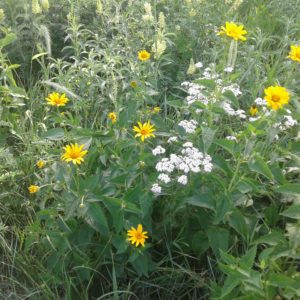
False sunflower mix.
South Dakota’s rural landscape consists of a mix of agriculture and rural urbanization. The fragmentation of the former prairie restricts many species to narrow corridors along roadways as they migrate through the landscape. Landscape nodes are a key component to migration corridors that provide resting areas for the migrating species, as well as a larger and more diverse area for food and shelter. The pollinator project has enhanced the resilience and sustainability of the prairie landscape by converting previously managed landscapes into naturalized habitats with wildflowers and native grasses. The conversion of these traditionally landscaped rest areas to native landscape also improves water infiltration into the soil.
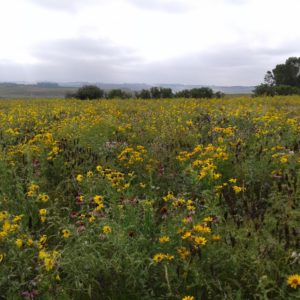
Hidewood: Northbound Rest Area
The SDDOT embarked on its Rest Area Pollinator Plot project beginning in 2018. This project complements the South Dakota Monarch Conservation and Management Strategic Plan. The project’s goal is to establish and increase habitats for the monarch butterfly and other pollinator species in South Dakota by providing food, shelter, and nesting resources on state-owned land. The five pollinator plots included in this undertaking cover more than 70 acres, with individual sites ranging from 8.5 acres to 16 acres. The pollinator plots are located at rest areas in Roberts, Moody, and Deuel counties along the north-south Interstate 29 corridor, which corresponds to the monarch butterfly migration path. The rest areas are anywhere from 46 to 53 miles apart and are compatible with the daily flight distances of the monarch butterfly.
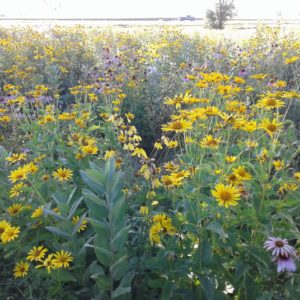
Flower mix with milkweed.
My firm, IMEG Corp., worked closely with the SDDOT, a seed supplier, and a contractor to develop a pollinator seed mix that included over 50 native forbs and grasses. At the time of planting, modifications were made to the base mix to accommodate the availability of individual species. The necessary changes to the seed mix also needed to consider providing species in the three blooming periods of spring, summer, and fall.
The challenge of developing a successful management strategy at these five rest areas required a balanced use of available tools and techniques to provide the least damaging approach to site maintenance while protecting the pollinator insect species and effectively controlling invasive and noxious weeds. Due to the habitat’s sensitivity, spot spraying and selective mowing techniques were implemented to focus only on areas with the largest population of invasive species.
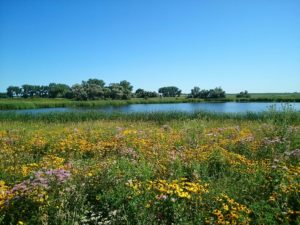
Glacial Lakes Rest Area: Roberts County
Measuring the success of the pollinator plots utilizes the floristic quality index (FQI) as a rapid assessment technique. After a three-year establishment period, the FQI scores have registered in the high-quality scoring range. In addition to the FQI assessment, the ground cover percentage is also being used as a monitoring tool. The ground cover ranges from 60 percent to 100 percent. As a result of using FQI, ground cover, and visual assessments, the areas in need of weed and invasive species control are approximately 10 percent of the total area.
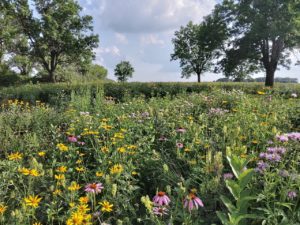
Hidewood: Southbound rest area
As part of the pollinator monitoring plan, we began counting milkweed stems. The sampling criteria were based on having greater than six stems per 1,500 square feet. In 2020 a total of 12 patches with 898 stems were recorded. In 2021 a total of 62 patches with 1,738 stems were recorded.
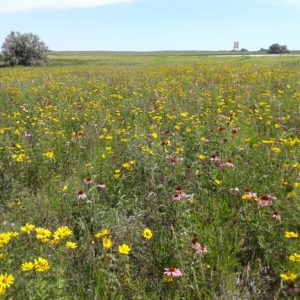
Hidewood: Southbound rest area
This large-scale pollinator habitat project is the first of its kind for the SDDOT. Their undertaking of this project allows us as a community to enjoy the annual emerging beauty of the prairie landscape. It is understandable why we celebrate Earth Day and World Landscape Architecture Month in April. As a landscape architect, creating, preserving, and re-introducing prairie landscapes is rewarding.
About the Author
 Paul Clinton is a Professional Landscape Architect and Wetland Delineator with IMEG Corp. He is involved in all aspects of landscape design, construction, and project management. Paul is experienced in site plans, landscape design, environmental permitting, environmental assessments, natural resource preservation, stream restoration, native planting, bank stabilization, and the construction and maintenance of wetlands.
Paul Clinton is a Professional Landscape Architect and Wetland Delineator with IMEG Corp. He is involved in all aspects of landscape design, construction, and project management. Paul is experienced in site plans, landscape design, environmental permitting, environmental assessments, natural resource preservation, stream restoration, native planting, bank stabilization, and the construction and maintenance of wetlands.
All photos by Paul Clinton, IMEG Corp.
***
Each author appearing herein retains original copyright. Right to reproduce or disseminate all material herein, including to Columbia University Library’s CAUSEWAY Project, is otherwise reserved by ELA. Please contact ELA for permission to reprint.
Mention of products is not intended to constitute endorsement. Opinions expressed in this newsletter article do not necessarily represent those of ELA’s directors, staff, or members.

